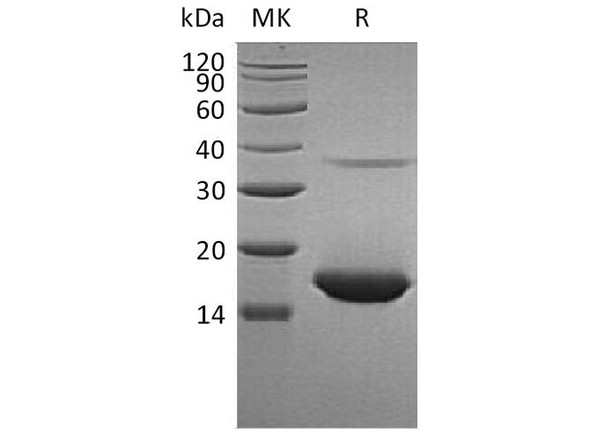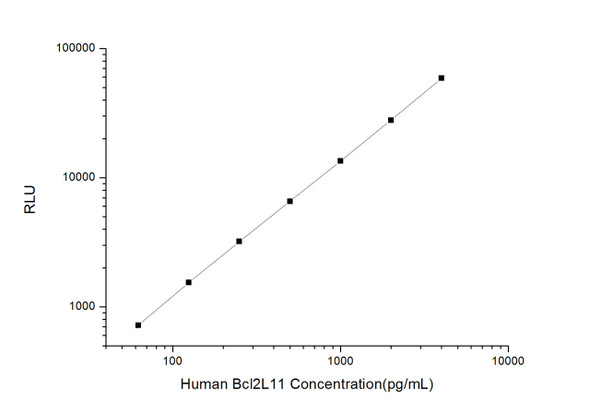Description
| Product Name: | Human BCL2L11 Recombinant Protein |
| Product Code: | RPPB2873 |
| Size: | 10µg |
| Species: | Human |
| Target: | BCL2L11 |
| Synonyms: | Bcl-2-like protein 11, Bcl2-L-11, Bcl2-interacting mediator of cell death, BCL2L11, BIM, BAM, BOD. |
| Source: | Escherichia Coli |
| Physical Appearance: | Sterile Filtered colorless solution. |
| Formulation: | BCL2L11 protein solution (0.5mg/ml) containing 20mM Tris-HCl buffer, pH8.0, 2M Urea, 20% glycerol, 5mM DTT and 300mM NaCl. |
| Stability: | Store at 4°C if entire vial will be used within 2-4 weeks. Store, frozen at -20°C for longer periods of time. For long term storage it is recommended to add a carrier protein (0.1% HSA or BSA).Avoid multiple freeze-thaw cycles. |
| Purity: | Greater than 80% as determined by SDS-PAGE. |
| Amino Acid Sequence: | MGSSHHHHHH SSGLVPRGSH MGSHMAKQPS DVSSECDREG RQLQPAERPP QLRPGAPTSL QTEPQDRSPA PMSCDKSTQT PSPPCQAFNH YLSAMASMRQ AEPADMRPEI WIAQELRRIG DEFNAYYARR VFLNNYQAAE DHPRMVILRL LRYIVRLVWR MH |
Bcl-2-like protein 11 (BCL2L11) is a member of the Bcl-2 family and contains a Bcl-2 homology domain 3 (BH3). BCL2L11 expression can be stimulated by nerve growth factor (NGF), in addition to the forkhead transcription factor (FKHR-L1) which proposes a role of the BCL2L11 gene in neuronal and lymphocyte apoptosis. BCL2L11 interacts with other members of the BCL-2 protein family, including BCL2, BCL2L1/BCL-X(L), and MCL1, and acts as an apoptotic activator. BimEL, BimL and BimS are the main isoforms which are ubiquitously expressed with a tissue-specific variation. The Isoform Bim-gamma, on the other hand, is most abundantly expressed in the small intestine and colon, and in lower levels in spleen, prostate, testis, heart, liver and kidney.
BCL2L11 Human Recombinant produced in E.Coli is a single, non-glycosylated polypeptide chain containing 162 amino acids (1-138 a.a) and having a molecular mass of 18.5kDa.BCL2L11 is fused to a 24 amino acid His-tag at N-terminus & purified by proprietary chromatographic techniques.
| UniProt Protein Function: | BIM: a pro-apoptotic member of the BCL-2 protein family. Interacts with other members of the BCL-2 protein family, including BCL2, BCL2L1/BCL-X(L), and MCL1, and act as an apoptotic activator. Its expression can be induced by nerve growth factor (NGF), as well as by the forkhead transcription factor FKHR-L1, which suggests a role in neuronal and lymphocyte apoptosis. Transgenic studies in the mouse suggested that this protein functions as an essential initiator of the apoptosis in thymocyte-negative selection. Nineteen alternatively spliced transcript variants of this gene have been reported. |
| UniProt Protein Details: | Protein type:Apoptosis Chromosomal Location of Human Ortholog: 2q13 Cellular Component: microtubule; mitochondrial outer membrane; extrinsic to membrane; endomembrane system; cytosol Molecular Function:protein binding; microtubule binding Biological Process: nerve growth factor receptor signaling pathway; positive regulation of apoptosis; apoptosis; cell-matrix adhesion; pigmentation during development; myeloid cell homeostasis; ear development; positive regulation of caspase activity; B cell apoptosis; cellular process regulating host cell cycle in response to virus; positive regulation of apoptosis by virus; mammary gland development; B cell homeostasis; positive regulation of neuron apoptosis; T cell homeostasis; kidney development; post-embryonic organ morphogenesis; caspase activation; spleen development; thymus development; in utero embryonic development; positive regulation of protein homooligomerization; male gonad development; positive regulation of cell cycle; regulation of organ growth; lumen formation; odontogenesis of dentine-containing teeth; DNA damage response, signal transduction resulting in induction of apoptosis; regulation of pigmentation during development; spermatogenesis; brain development |
| NCBI Summary: | The protein encoded by this gene belongs to the BCL-2 protein family. BCL-2 family members form hetero- or homodimers and act as anti- or pro-apoptotic regulators that are involved in a wide variety of cellular activities. The protein encoded by this gene contains a Bcl-2 homology domain 3 (BH3). It has been shown to interact with other members of the BCL-2 protein family and to act as an apoptotic activator. The expression of this gene can be induced by nerve growth factor (NGF), as well as by the forkhead transcription factor FKHR-L1, which suggests a role of this gene in neuronal and lymphocyte apoptosis. Transgenic studies of the mouse counterpart suggested that this gene functions as an essential initiator of apoptosis in thymocyte-negative selection. Several alternatively spliced transcript variants of this gene have been identified. [provided by RefSeq, Jun 2013] |
| UniProt Code: | O43521 |
| NCBI GenInfo Identifier: | 20336315 |
| NCBI Gene ID: | 10018 |
| NCBI Accession: | NP_619527.1 |
| UniProt Secondary Accession: | O43521,O43522, Q0MSE7, Q0MSE8, Q0MSE9, Q53R28, Q6JTU6 Q6T851, Q6TE14, Q6TE15, Q6TE16, A8K2W2, |
| UniProt Related Accession: | O43521 |
| Molecular Weight: | 22,171 Da |
| NCBI Full Name: | bcl-2-like protein 11 isoform 1 |
| NCBI Synonym Full Names: | BCL2-like 11 (apoptosis facilitator) |
| NCBI Official Symbol: | BCL2L11�� |
| NCBI Official Synonym Symbols: | BAM; BIM; BOD�� |
| NCBI Protein Information: | bcl-2-like protein 11; bcl-2 interacting protein Bim; bcl-2-related ovarian death agonist; bcl-2 interacting mediator of cell death |
| UniProt Protein Name: | Bcl-2-like protein 11 |
| UniProt Synonym Protein Names: | Bcl2-interacting mediator of cell death |
| Protein Family: | Bcl-2-like protein |
| UniProt Gene Name: | BCL2L11�� |
| UniProt Entry Name: | B2L11_HUMAN |






